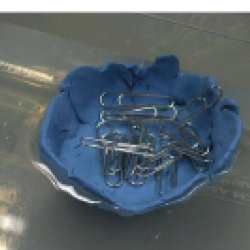Source Institutions
Source Institutions
Add to list Go to activity
Activity link broken? See if it's at the internet archive

In an investigation called "Shape It!" learners craft tiny boats out of clay, set them afloat on water and then add weight loads to them, in order to explore: how objects stay afloat in water; what the relationship is among surface tension, buoyancy, density and displacement; and how shape, size, and type of material affect an object's ability to remain buoyant. The introductory text discusses how heavy steel ships can float on bodies of water like rivers, bays and oceans.
- 10 to 30 minutes
- 30 to 45 minutes
- $1 - $5 per group of students
- Ages 8 - 14
- Activity, Lesson/Lesson Plan
- English
Quick Guide
Materials List (per group of students)
- medium to large plastic container—wide open top, filled with water
- 1/2 stick of modeling caly
- paper clips
- marbles
- student journals and writing tools
Subjects
-
Engineering and Technology
-
Engineering
- Transportation Engineering
-
Engineering
-
Physical Sciences
-
Motion and Forces
- Gravity
-
States of Matter
- Liquids
-
Structure and Properties of Matter
- Mass and Weight
- Volume and Density
-
Motion and Forces
-
The Nature of Science
-
The Scientific Process
- Asking Questions
- Conducting Investigations
- Gathering Data
- Formulating Explanations
-
The Scientific Process
Informal Categories
- Transportation
Audience
To use this activity, learners need to:
- see
- read
- touch
Learning styles supported:
- Involves teamwork and communication skills
- Involves hands-on or lab activities
Other
Components that are part of this resource:
Includes alignment to state and/or national standards:
This resource is part of:
Access Rights:
- Free access
By:
Source Collection
- Science After School Consumer's Guide
Rights:
- All rights reserved, State of New Jersey, 2006
Funding Source:
- No Child Left Behind Act of 2001
